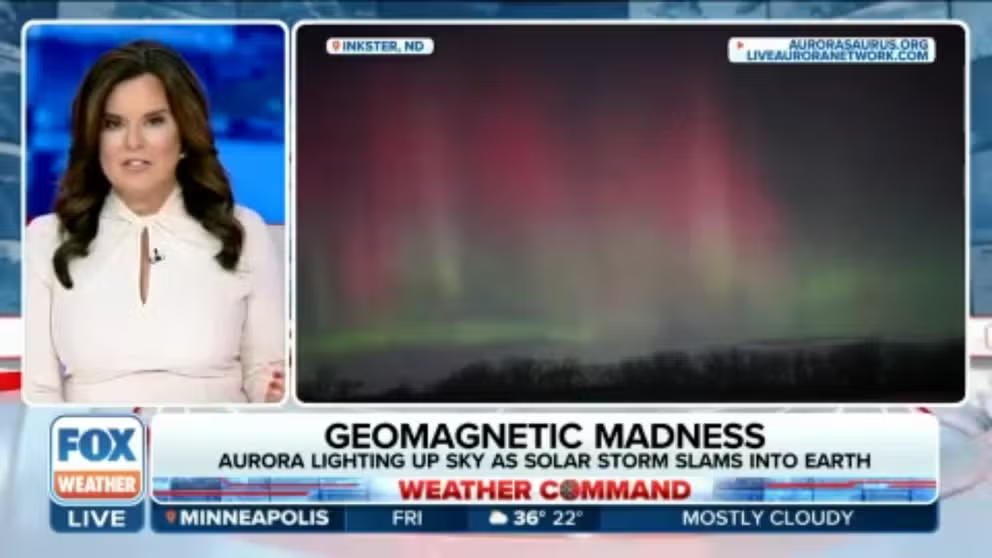Geomagnetic storm watch on Tuesday as Sun continues to send eruptions toward Earth
NOAA's Space Weather Prediction Center issued a moderate G1 Geomagnetic Storm Watch for Tuesday. Moderate Northern Lights activity is possible Monday night, with the potential to see the lights in the northern U.S.
Geomagnetic storm triggers vivid display of Northern Lights across the North Friday
Skies lit up in jaw-dropping colors across North Dakota as a strong geomagnetic storm struck the Earth's atmosphere early Friday morning.
A series of eruptions from the Sun continue to send plasma blasting toward Earth, causing NOAA's Space Weather Prediction Center (SWPC) to issue another Geomagnetic Storm Watch and creating vivid Northern Lights displays across parts of the U.S.
The SWPC issues geomagnetic storm alerts to warn of potential interference with communication systems and spacecraft operations. During significant solar storms, widespread power outages are possible, and communication systems are subject to failure. Solar wind causes the reactions in Earth's atmosphere that create the Aurora Borealis or Northern Lights. Intense space weather events can cause Aurora lights to appear farther away from Earth's poles, as they did last week.
WHAT ARE THE 5 CATEGORIES THAT MEASURE GEOMAGNETIC STORMS?
This latest Geomagnetic Storm Watch was issued for Monday and Tuesday because of a coronal hole high-speed stream, or CH HSS. The SWPC issued a moderate G2 Geomagnetic Storm Watch for Monday as a fast solar wind associated with the CH HSS was expected to arrive early Monday to midday.
Minor G1 levels are likely through Tuesday, according to NOAA.
When will Aurora lights appear?
The SWPC Aurora dashboard showed moderate Northern Lights activity began Sunday night into Monday morning. On Monday night, Auroras were again possible with the potential to see the lights as far south as southern Wisconsin and the Dakotas.

(FOX Weather)
The Aurora lights can be seen low on the horizon with a clear sky. Unfortunately, much of the northern U.S. will be under thick cloud cover on Monday night, according to the FOX Forecast Center.
7 THINGS TO KNOW ABOUT THE NORTHERN LIGHTS
Boise, Idaho, and Valentine, Nebraska, look to have the lowest amount of cloud cover for this geomagnetic storm event.
For places that have frequent Auroras, like Alaska, the light show should be spectacular. The University of Alaska Fairbanks Geophysical Institute Aurora forecast shows the Northern Lights appearing throughout the entire state of Alaska.
What is a coronal hole high-speed steam?

A coronal hole seen in the dark area of the Sun. (Image: NOAA GOES-18 SUVI)
(NOAA)
A strong solar flare and related Coronal Mass Ejections (CME) triggered the previous strong G3 solar storm at the end of last week. This Geomagnetic Storm Watch was prompted by a different solar phenomenon known as a coronal hole.
Unlike CMEs, which take between one and three days to reach Earth's atmosphere, coronal holes can have delayed impacts.
A coronal hole looks like a vast area of blackness in the Sun because coronal holes don't have plasma. The plasma is missing because it travels out into space, streaming along the Sun's magnetic field lines.
MEET STEVE: A NEW SPACE WEATHER PHENOMENA BEING SEEN WITH AURORA LIGHTS
The most recent coronal hole can be seen near the center of the Sun in the image above from NOAA's GOES-18 satellite instrument, Solar Ultraviolet Imager (SUVI).
A coronal hole high-speed stream (CH HSS) can sometimes come back around and hit the Earth twice because the Sun spins every 27 days. If Earth gets hit by a high-speed stream, there's a chance it could strike again in 27 days.
The geomagnetic storms and associated Aurora activity are because the Sun's activity is increasing as it approaches the Solar Maximum during an 11-year solar cycle.
